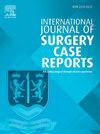Intralobar pulmonary sequestration associated with a bronchogenic cyst in an elderly woman: A case report
IF 0.6
Q4 SURGERY
引用次数: 0
Abstract
Introduction and importance
Congenital lung malformations (CLMs) are rare congenital abnormalities resulting from abnormal development of the foregut and tracheobronchial tree. Pulmonary sequestration (PS) and bronchogenic cysts (BC) are two such anomalies, and while they can occasionally coexist, the combination of intralobar pulmonary sequestration (ILS) and BC is exceptionally rare. Only a limited number of cases have been reported in the literature. This case presents a unique occurrence of ILS and BC in the left lower lobe of an elderly woman, contributing to the understanding of these anomalies' shared origin.
Case presentation
A 57-year-old woman with no significant medical history presented with left-sided chest pain and cough lasting for one month. Chest CT revealed a well-circumscribed cystic lesion in the left lower lobe, initially suspected to be a hydatid cyst. During surgery, a feeding artery originating from the descending thoracic aorta was found, confirming ILS. The cyst contained a thick chocolate-like fluid, suggesting a BC. Pathological analysis confirmed the presence of a unilocular cyst lined by respiratory epithelium, with features consistent with BC and ILS. The postoperative recovery was uncomplicated.
Clinical discussion
CLMs include various malformations such as foregut duplication cysts, PS, and congenital pulmonary airway malformations. BCs arise from the ventral foregut and are usually asymptomatic but may present with symptoms due to infection or complications. PS is characterized by non-functioning lung tissue supplied by an aberrant systemic artery. CT features of PS vary, and angiography remains the gold standard for diagnosis. Two types of sequestration exist: extralobar and intralobar. ILS, typically considered acquired, has been occasionally linked to congenital anomalies, suggesting an embryological origin. The coexistence of BC and ILS is extremely rare, with only 10 cases reported in the literature.
Conclusion
The coexistence of Bronchogenic Cyst (BC) and Intralobar Pulmonary Sequestration (ILS) is a rare condition, with only a few cases documented. This case highlights the complexity of diagnosing these pulmonary malformations and suggests a potential shared congenital origin, challenging previous theories that ILS arises from chronic inflammation. Further studies are needed to elucidate the embryological link between these malformations and their clinical implications.
求助全文
约1分钟内获得全文
求助全文
来源期刊
CiteScore
1.10
自引率
0.00%
发文量
1116
审稿时长
46 days

 求助内容:
求助内容: 应助结果提醒方式:
应助结果提醒方式:


